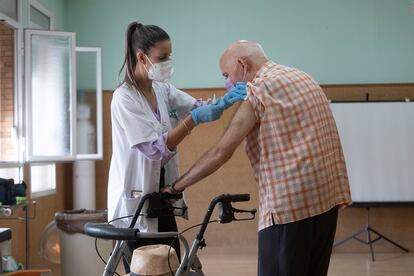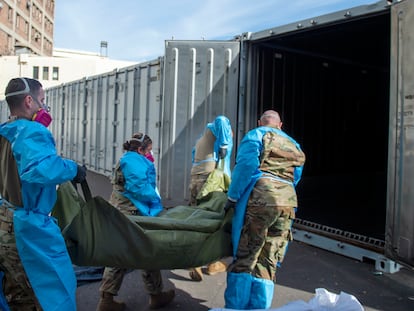Universal flu vaccine using RNA technology successfully tested in mice
Trials in rodents and ferrets show that it protects against all known versions of the virus by using the same technique that has been effective against Covid-19

Using the same technology behind the Covid-19 vaccines developed by Pfizer-BioNTech and Moderna, US researchers have created a universal flu vaccine candidate. The candidate – it has only been tested it in mice and ferrets – is considered universal because it provides protection against 20 known influenza A and B virus subtypes. Although only a few subtypes affect humans, the others spread among mammals and birds, and if one of these were to leap to humans and combine with the common flu, it could trigger a pandemic.
Every year there is a new flu vaccine. This is partly due to a protein called hemagglutinin (HA). Influenza in humans is caused by two subtypes: type A and type B. For example, the A H1N1 and H3N2 flu circulate among humans. The H refers to hemagglutinin (there are 18 different versions) and the N refers to the molecule neuraminidase (there are 11 versions), which is also present on the viral surface. Meanwhile, only two different hemagglutinin versions of the type B influenza virus are known.
Just as the coronavirus vaccines focused on the S spike, most flu vaccines target hemagglutinin. The problem is that, firstly, researchers do not know which subtype will be spreading next winter, and secondly, the HA head has a high mutation rate, which makes creating a universal vaccine difficult. For this reason, recent efforts have been directed against the HA stem, which mutates less often and tends to be very similar between the different subtypes.
With the new vaccine candidate, researchers from the University of Pennsylvania have targeted all subtypes of the influenza at the same time. To do this, they used messenger RNA technology, which is behind the success of the Covid-19 vaccines by Moderna and Pfizer-BioNTech. This technique introduces the genetic instructions into nanospheres, so that the host cell that makes the HG does not have a viral load. Through this method, they made 20 vaccines in one. Before combining them in a formula, the researchers tested each nanocapsule separately, to ensure its effectiveness. The next step was to test the vaccine candidate on several groups of mice, to determine whether it would remain effective and if there was any cross-reaction. This is the first time that mRNA technology has been used to search for a universal vaccine candidate.
Bolivian virologist Claudia Arévalo, the lead author of the study, explains that this approach would have been impossible using more traditional platforms, such as those that use viral proteins. This approach would have required 20 different recombinant proteins to be purified and added to an adjuvant, an ingredient used in vaccines that creates a stronger immune response – “a very expensive and laborious process,” said Arévalo.
The other standard approach, of creating a vaccine that uses an inactivated virus, also comes with challenges, “such as having to isolate the strains and propagate them successfully,” she explained. “The strains we included are all known influenza subtypes, which means some have pandemic potential and others have not yet crossed over from animals, so you can imagine the challenges of isolating and spreading viruses like those.”
According to the results of the vaccine candidate, which were published Thursday in the prestigious journal Science, the mice generated antibodies against the 20 subtypes, with immunization lasting at least four months. Two weeks after being vaccinated, the scientists infected several groups of these mice with two different subtypes of influenza A, one of them similar to the predominant influenza virus among humans, H1N1. All the mice in the control group, which had been injected with a placebo instead of the vaccine formulation, died. However, those vaccinated and exposed to the H1NI virus did not die or even lose weight. No viral load was detected in the lungs either. The mice that were immunized and exposed to the rarest subtype became ill, but most recovered after seven or eight days. Only 20% died. According to the authors, this means the vaccine candidate does not prevent infection, but does prevent against the severest form of the virus, even against subtypes’ whose antigen was not included in the vaccine.
“Current flu vaccines do not protect against flu viruses with pandemic potential. This vaccine, if it works well in people, would achieve this,” said Adolfo García-Sastre, director of the Institute for Global Health and Emerging Pathogens at Mount Sinai Hospital in New York, in statements to the SMC Spain platform. “[The results] are very promising and, although they suggest the ability to protect against all subtypes of influenza viruses, we cannot be sure of this until clinical trials are carried out in volunteers,” added García-Sastre, who was not involved with the research.
Víctor Jiménez Cid, professor of microbiology at Madrid’s Complutense University, says it is important to find vaccines that not only target the subtypes that affect humans.“The seasonal Influenza A viruses that spread among the human population are just H1N1 and H3N2. So why include other H antigenic types? Firstly, A viruses are zooonotic and, although the rest don’t affect the human population, they do spread among other animals,” he explained. “This means that a new pandemic virus could emerge if one of these types does an antigenic leap, triggering a new virus.”
Indeed, the four big pandemics of the last century were due to this spillover: the 2009 swine flu pandemic, the 1968 Hong Kong flu; the 1957 Asian flu pandemic and the 1918 influenza pandemic, commonly known by the misnomer Spanish flu.
Tu suscripción se está usando en otro dispositivo
¿Quieres añadir otro usuario a tu suscripción?
Si continúas leyendo en este dispositivo, no se podrá leer en el otro.
FlechaTu suscripción se está usando en otro dispositivo y solo puedes acceder a EL PAÍS desde un dispositivo a la vez.
Si quieres compartir tu cuenta, cambia tu suscripción a la modalidad Premium, así podrás añadir otro usuario. Cada uno accederá con su propia cuenta de email, lo que os permitirá personalizar vuestra experiencia en EL PAÍS.
¿Tienes una suscripción de empresa? Accede aquí para contratar más cuentas.
En el caso de no saber quién está usando tu cuenta, te recomendamos cambiar tu contraseña aquí.
Si decides continuar compartiendo tu cuenta, este mensaje se mostrará en tu dispositivo y en el de la otra persona que está usando tu cuenta de forma indefinida, afectando a tu experiencia de lectura. Puedes consultar aquí los términos y condiciones de la suscripción digital.











































